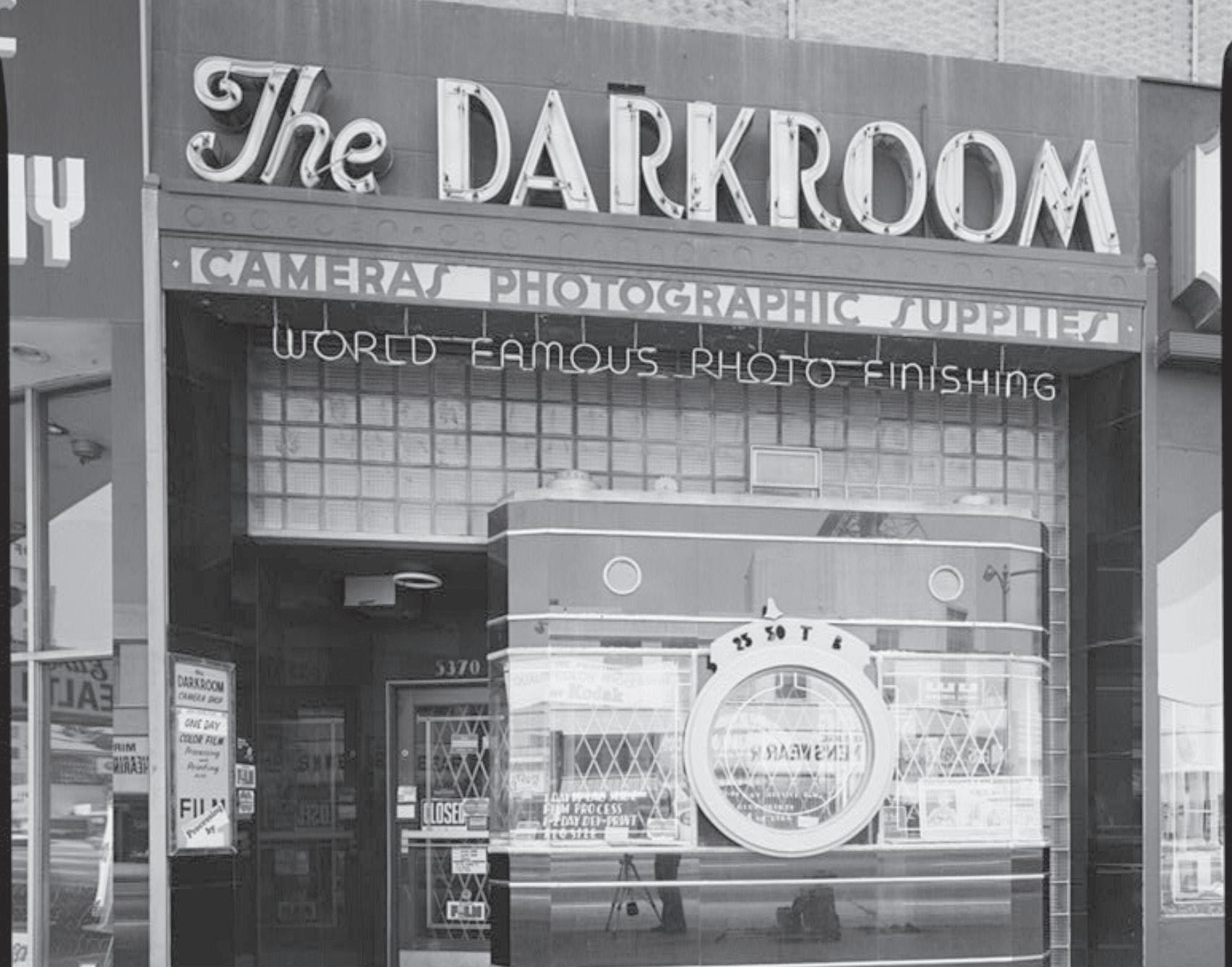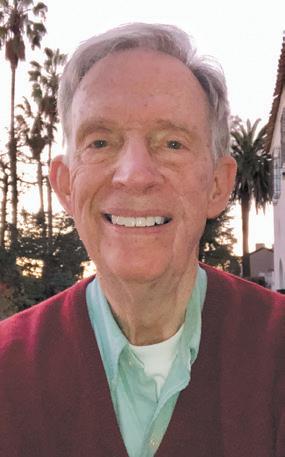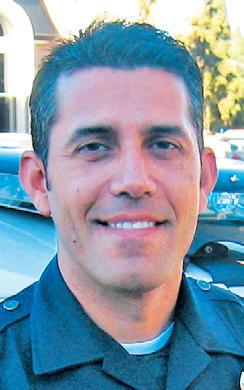








The elegant department stores of a bygone era are no longer. Some have been replaced with state-of-the-art museums. The Petersen Automotive is one; the former gold-mosaic exterior of the May Company store — now part of the Academy Museum — is another.
Still to come are more high-rise buildings to house a growing population within walking distance of the new Metro subway stops bookending the Miracle Mile Historic District.
The road to the future is a slow one. It can take years while developers appease community and labor groups and navigate the city permit process.
“We are a patient lot,” developer and longtime owner of the Mirabel property at 5411 Wilshire Blvd., Wally Marks, noted in an email to the Chronicle
His family company, Walter N. Marks, Inc., is hoping to begin construction next year on the Mirabel, which, when it opens, will add a gleaming 42-story, mixed-use residential tower with 348 apartments and ground-floor retail.
Mirabel
“The tower is a derivative of both the past and the future,” its design firm explains on the

website keatingarchitecture. com. “The rich heritage of the city of Los Angeles in the early 20th century Art Deco period,” the later 1920s and ’30s, are prevalent in the Mirabel design, Keating continues. Its 530-foot tower features a glass exterior and has a curvilinear form, a rooftop deck and common open space above a parking podium.
The building, 477,000 square feet, includes 29 affordable residential units for very lowincome households.
A state of California density bonus program allows for more floor area than otherwise would have been allowed by local zoning.
As part of the Mirabel project, the façade of an historic 1936
Streamline Moderne Sontag Drug Store building — at the corner of Wilshire and Cloverdale Avenue — will be preserved around part of the 14,000 square feet of groundfloor retail space. The other corner of the site formerly was the home of a Staples store (now moved further west on Wilshire).
The building will have parking for a total of 478 cars in an automated, three-level, underground garage modeled after a similar one at Marks’ Helms Bakery property in Culver City.
But Marks expects many of his new tenants to walk the one block to and from the new D (formerly Purple) Line Metro station at La Brea

when the subway extension to La Cienega Boulevard opens in 2025.
Last fall, the City of Los Angeles Dept. of City Planning issued a Notice of Preparation for the Environmental Impact Report (EIR) and completed a public comment period.
Now City Planning officials are preparing a Sustainable Communities Draft EIR.
The project will take an estimated 36 months of construction once the EIR is reviewed and approved. Wilshire Courtyard revamp delayed
Onni Group, founded in Vancouver, Canada, and with projects across North America, had been working to seriously revamp the existing
Wilshire Courtyard office complex at 5700 and 5750 Wilshire Blvd., a property that Onni purchased in 2019.
The proposed 2.3 millionsquare-foot complex would feature two interconnected glass-clad towers standing 35and 41-stories high. The latter tower would reach 655 feet and face Masselin Avenue to the east. The shorter of the two buildings would face Curson Avenue to the west.
The towers are to stand atop a seven-story parking podium. Two floors could be turned into office space in the future should conditions warrant. Features include landscaped bridges, terraces and, at street-level, a restaurant and
(Please turn to Page 3)

(Continued from Page 2)
grocery and retail tenants in a design by Chicago architecture firm Solomon Cordwell Buenz.
The project would preserve the southern sections of the existing terraced six-story office structure, abutting the residential area of this part of the Miracle Mile, and the project also would preserve the park space on Eighth Street. A portion of the existing building’s three subterranean parking levels would be removed, while 2,901 of its parking spots would be retained, for a total of 4,650 auto stalls.
Leasing challenges in the commercial office sector have affected Onni. In 2023, the Wilshire Courtyard lost existing office tenants, and, at the end of last summer, Onni received an extension of its $348 million loan on the Wilshire Courtyard.
The loan extension is until 2025, and it now is uncertain when the high-rise expansion project may break ground. It still is pending approvals by the City of Los Angeles, including a zone change and a master conditional use permit. A draft EIR is being prepared by the City Planning Dept.
Wilshire Cloverdale
Onni Group’s other Miracle Mile project, Wilshire and

Cloverdale, at 5350-5374
Wilshire Blvd., is a proposed mixed-use apartment complex projected to reach 43 stories.
According to city records, the proposed apartment tower includes 419 housing units, 47 of which are for extremely low-income residents, above 2,700 square feet of retail space. A five-story podium at the base of the apartment tower and subterranean levels will serve 443 cars.
The developer has asked for entitlements to include Transit Oriented Communities (TOC) benefits. The project is close to the Wilshire / La Brea subway station set to open in 2025.
The developer seeks TOC density bonuses to allow for a
larger building on account of the inclusion of the affordable housing units.
The 530-foot-tall Art Decostyle glass building has been designed by Downtown-based MVE + Partners.
The plan proposes retention of the existing retail buildings fronting the south side of Wilshire in this block. Included is Historic-Cultural Monument No. 451, the façade of The Darkroom. It originally was a camera shop and is now a restaurant. It and the 42,000 square feet of existing retail space along Wilshire, including one storefront that houses a U.S. Post Office, would continue in use while the new tower is built on the existing
parking lots behind them.
An initial study for the project was prepared and published in May 2023 by the City Planning Dept., and a draft EIR is being prepared, Planning Dept. officials say.
3rd & Fairfax Construction continues at 3rd & Fairfax, a mixeduse project on the site of the former Town & Country shopping center.
The longtime shopping destination on the south side of Third Street, across from the Original Farmers Market, will include a new eightstory, mixed-use complex of 311 studio, one-, two- and three-bedroom apartments above 84,000 square feet of retail space.
The project was downsized from 331 units “as a result of working through the unit plan layouts for the building to lay out the best units possible,” George Elum, managing director for the Los Angeles Region of real estate developer Holland Partner Group, told us in an email.
He added, “A pedestrian paseo on the ground floor connects the existing western shopping center to Ogden to allow pedestrians to permeate through the building and not have to walk around the entire project. We will be commissioning a local artist to design
the pedestrian paseo aesthetic,” he added.
The project is slated to have parking for 996 vehicles in a two-level subterranean garage and a three-level podium structure.
The western part of the property, now home to a Whole Foods Market, CVS Pharmacy and Citibank, remains on the Third and Fairfax southeast corner.
“We are scheduled to deliver the project in the first half of 2026,” Elum told us.
The final design is a long way from the original proposal for a 26-story residential tower that was reduced to an eight-story building after community outcry, including from Hancock Park Elementary School, which is directly south of the project.
In 2020, the owners of the Third and Fairfax property erected a 10-foot-high masonry block wall between the school and the service areas of Whole Foods Market and CVS Pharmacy to address the school’s noise concerns.
Among the buildings demolished to make room for the new development were a Kmart and the longtime home to Andre’s Italian Restaurant. A new location for Andre’s at the historic Dominguez Building at 5400 Wilshire Blvd. is expected to open this month.

Councilwoman Katy Yaroslavsky of the vast City of Los Angeles Fifth Council District — that extends from Brentwood to Palms and all the way to Western Avenue — will soon open her new district office in the Miracle Mile. We spoke with the councilwoman about why this new office is important to her, what her first year on the City Council has been like and what her top priorities are for the years to come.
Yaroslavsky expressed excitement that her new district office will be located on the southwest corner of Wilshire Boulevard and Cochran Avenue, just a block away from the new La Brea Avenue “D” Line Metro subway station.
of vast Los Fifth Council — that extends from Brentwood to all Western Avenue — will soon district office Miracle Mile. We spoke councilwoman about why office to her, what first the City Council has been and what for the to come. expressed citement her office located on southwest Wilshire Boulevard Cochran just a block away from Brea Metro people be able office by transit told us of the new space her office host community meetings gatherings. think it’s that people their government — ularly government,”
CD5
She likes that people will be able to get to her office by way of public transit and told us that the design of the new space will allow her office to host community meetings and gatherings. “I think it’s important that people feel connected to their government — particularly local government,” said the councilwoman. CD5 represents a part of a city that’s not adjacent to where City Hall is. “In a way,” she told us, “we are now bringing City Hall to the district… It’s going to be a hub of community engagement.”
a part of not adjacent to where Hall a told us, “we bringing City district… It’s to be a hub community told us that learning curve was this year. She member being an working with working with she things are in a good.” With a full, strong
Yaroslavsky told us that the learning curve was steep this first year. She went from being a staff member (for a county supervisor) to being an elected official and from working with the county to working with the city. But she feels things are now “really humming, in a way that feels good.” With a full, strong staff, the CD5 team is working

on four main things: housing and homelessness, investing in making communities more livable, climate and sustainability and accountability and transparency at City Hall.
Housing
on four and in making communities more livable, climate and and accountability and transparency at Hall. Housing to at
double the amount of interim homeless housing in council district — going from 99 to 200 by the end with the of that again of years.
Yaroslavsky hopes to at least double the amount of interim homeless housing beds in the council district — going from 99 to 200 — by the end of 2024, with the goal of doubling that again within a couple of years.
But a focus is also being put on the side of housing. being done to ensure affordable units side the otherwise market rate projects can be accessed people coming interim housing, is also working to accelerate the construction of and middle-income This is what “the missing middle.”
But a focus is also being put on the permanent side of housing. Work is being done to ensure the affordable units inside the city’s otherwise market rate projects can be accessed for people coming out of interim housing, and the City Council is also working to accelerate the construction of affordable and middle-income housing. This is what Yaroslavsky called, “the missing middle.”
Transportation
Transportation
As a member of City Council Transportation mittee — happens to the first committee in of history — is working
As a member of the City Council Transportation Committee — which happens to be the first all-woman committee in City of Los Angeles history — Yaroslavsky is working with

children, the level of patience required to do the job of a councilperson well is a lot.
to concrete improve safety of our streets. office also Clean Team, group people who are out five a week picking up trash, clearing weeds, trimming trees and clearing storm drains. So the has repounds of trash and 600 bulky items.
her colleagues to take concrete actions to improve the safety of our streets. Her office also created the CD5 Clean Team, a group of people who are out five days a week picking up trash, clearing weeds, trimming trees and clearing storm drains. So far, the team has removed 60,000 pounds of trash and 600 bulky items.
Sustainability
Sustainability
Working Los Angeles in greener Yaroslavsky told us that a partnership the Los Angeles Deof and Power (DWP), Sanitation and the Metropolitan was “This will help meet our goal of sourcing 70 of our locally by 2035,” she told us.
Working to push Los Angeles in a greener direction, Yaroslavsky told us that a partnership between the Los Angeles Department of Water and Power (DWP), LA Sanitation and the Metropolitan Water District was recently secured. “This will help meet our goal of sourcing 70 percent of our water locally by 2035,” she told us.
The councilwoman is also accelerate the phase-out oil extraction in Angeles. is “formidaindustry,” I days of oil drilling in neighborhoods have to be over and we can’t wait years.”
The councilwoman is also working to accelerate the phase-out of oil extraction in Los Angeles. Oil is a “formidable industry,” she said. “But I think the days of oil drilling in neighborhoods haveto be over — and we can’t wait 20 years.”
Accountability
Accountability
To the accountability and City Hall, a require when elected official’s spouse, or staff is a registered lobbyalso to an office would avoid potential conflicts of Miracle Mile
To improve the accountability and transparency at City Hall, Yaroslavsky brought a motion that would require disclosures when an elected official’s spouse, relative or staff member is a registered lobbyist. The councilwoman is also working to establish an office of compliance which would help councilmembers avoid potential conflicts of interest.
Miracle Mile
As to the goings-on in the Miracle Mile, Yaroslavsky thinks the fact that Metro’s new D Line (Purple Line) — which will enable people to get from Mid City to Downtown in 10 to 12 minutes — is going to change the way residents experience living in Mid City Los Angeles.
As goings-on the Miracle Mile, Yaroslavsky thinks fact that new D Line (Purple Line) — will ento from City Downtown in to 12 minis going change the living in
The cited big beyond the subway construction underway in the Miracle Mile area, as LACMA “Miracle is one of my places in there’s a history and a lot of great architecture, it’s exciting to it,” said.
The councilwoman cited other big projects beyond the subway construction underway in the Miracle Mile area, such as the LACMA expansion. “Miracle Mile is one of my favorite places in the city because there’s a lot of history and a lot of great architecture, and it’s exciting to be a part of it,” she said.
When asked what she has learned about herself in the past year, the mother of three told us that, though she learned patience from having
When asked has learned about herself the year, mother of three told us though she learned from having
“When you get screamed at during meetings for doing what you think is the right thing, it’s hard to take. But I think a lot of people’s frustration and anger comes from a sense of feeling powerless.” Yaroslavsky told us her patience muscle has become further developed, but her experiences have also reminded her of solutions. “When we empower people and treat people with respect,” she said, “it changes how people see the work that we do.”
the of required to of a well a “When you during meetings for doing what think is right it’s hard to But I think a lot of and a sense feeling powerless.” her patience has further developed, but her have reminded her of solutions. we people and treat people with respect,” said, “it changes how work that we do.”
Copper wire thefts
wire thefts few days after this Councilwoman
A few days after this interview, Councilwoman Yaroslavsky was one of 13 (of 15) members of the City Council voting in favor of proposals to address the growing crisis of thefts of copper wire from streetlights and elsewhere, as well as thefts of metal markers on gravestones and civic monuments.
15) members of the in favor of to address crisis thefts copper where, as as thefts markers on gravestones and Soto-Martinez “no”
Soto-Martinez votes “no”
By contrast, local 13th Council District Councilmember Soto-Martinez voted against the proposals,
Council District Soto-Martinez voted against the
as on Feb. 14 (tinyurl.com/k92zuv9y):
as reported on Feb. 14 in the Los Angeles Daily News (tinyurl.com/k92zuv9y):
“Soto-Martinez of the some might people are financially acts of desperaHe acknowledged copper theft range from members organized ‘I implore you that it’s probably cheaper to invest into having to of that really said.”
“Soto-Martinez spoke in defense of the criminals, saying some might be people who are financially struggling and committing acts of desperation. He also acknowledged that those committing copper theft range from struggling individuals to members of organized crime. ‘I implore you that it’s probably cheaper to invest into young people’s future than having to deal with a system of criminalization that really just gets us nowhere,’ he said.”


Having successfully overcome several significant technical challenges in the construction of the D Line Extension (the subway link between Western Avenue and Westwood) — including geologic conditions near the Tar Pits — Metro has confirmed that service to the Segment One stations (at La Brea, Fairfax and La Cienega) should be underway in the spring of 2025. A rumor we have heard is that tunneling for the entire nine-mile subway extension project is now finished.
Temporary decking removal has now been completed for the segment. Major concrete pours at all stations are nearing completion, and we are told that a majority of track for the segment has also been installed. Street restorations — including replacement of curbs, gutters, sidewalks, streetlights, traffic signals, final asphalt paving, signage, striping and street trees — are now concluding.
The work remaining will be interior design, electrical and mechanical, as well as the installation of train control systems in stations and tunnels.
Work to complete station plazas will be starting in April for both the Wilshire

/ La Brea and the Wilshire / Fairfax stations, Metro communications manager Dave Sotero told us. Work on the Wilshire / La Cienega plaza will start in June.
Artwork
Artists have been selected to create site-specific artwork for the D Line Extension. At the Fairfax station, artists are Ken Gonzales-Day, Karl Haendel and Susan Silton. The La Brea station artists are Mark Dean Veca, Fran Siegel and Eamon Ore-Giron. Metro will host Meet the Artist opportunities for the public this spring. Aside from the artwork, we are told all of the new stations will
look similar inside and have similar architecture for their above-ground entrances. Clean, safe?
When asked how the new line will be kept clean and safe, Sotero said, “The D Line Subway Extension project will benefit from the resources of Metro’s multi-layered public safety plan that has already proven successful in improving safety on the Metro System.” Included in this plan, implemented in July 2023, are contracted security officers, Metro Transit Security, law enforcement personnel and Metro Ambassadors. There are also homeless- and mental
health trauma-informed crisis intervention teams. Increased cleaning services are included in the plan, as well. There will
be around-the-clock cleaning of the transit stations, and facilities systems technicians also inspect overall station conditions regularly, Sotero explained.
Mobility benefits
The subway extension project is expected to have great mobility benefits for the entire Los Angeles County region. Having a reliable, high-speed connection between Downtown Los Angeles and the Westside (to reach the Veterans’ Administration) will provide an alternative for commuters stuck in rushhour delays on surface streets and freeways. It is estimated that subway users will be able to get from Downtown to Westwood in approximately 25 minutes.


The developer of a proposed expansion and modernization of CBS Television City, at Beverly and Fairfax, received requests last month to reduce the density and mass of the TVC 2050 project prior to public hearings which are expected to start this month.
Councilwoman Katy Yaroslavsky, CD5, asked the property owner and developer Michael Hackman and Hackman Capital Partners Television City LLC, in a Feb. 14 letter, to reduce the total maximum square footage and the height along the perimeter of the property at Fairfax Avenue and Beverly Boulevard and to provide greater setbacks and “building stepbacks” to better separate the project from neighboring properties. A transportation program to reduce single-occupant vehicles was also requested.
“It is my hope that you will incorporate these revisions to the project proposal ahead of the public hearings, which I have asked the Department of City Planning to initiate in March,” Yaroslavsky wrote.
“I remain optimistic that implementing these adjustments will enhance the project’s alignment and acceptance within the com-

munity and lead to City Council action by this summer,” she added.
Neighbors for Responsible TVC Development
Meanwhile, Neighbors for Responsible TVC Development also wrote a letter asking that the size of the project be reduced by 700,000 square feet.
“We support a modern, 21st-century studio at TVC.
Along with our neighbors, we have supported CBS Tele-
vision City for decades and we wish to continue to do so. But we do not support an office park at the site,” Neighbors co-chairs Shelley Wagers and Danielle Peters wrote in the Feb. 14 comment letter to the City Planning Dept. on the final Environmental Impact Report (EIR) for the proposed development.
“The Applicant has told us that the offices will be related to uses that support studios, such
as human resources and marketing offices for studios. But the evidence of current tenants at the applicant’s other studio properties says otherwise. For example, at Manhattan Studios, tenants include realtors, law firms and carpet cleaners.
“The neighborhood surrounding TVC is already highly impacted by a number of dense, urban uses. An office park component in addition to an operational
studio is just too much,” the Neighbors’ letter continues.
The developer had not responded to emails by press time but has expressed in the past that the project will bring the historic studio into the 21st century and create new jobs and infuse new energy to the area.
Frustrated with the density and height of the proposed redevelopment, and several “unproductive” meetings with the developer, the Neighbors community group asked the City Council Office and the City Planning Dept. to “refocus the project and emphasize what we think is the most important issue here — modernizing a production studio,” Neighbors co-chair Wagers told us in a phone interview last month.
The community group, comprised of neighbors and nearby businesses, wants developer Hackman Capital Partners to trim 700,000 square feet from the proposed 1.9 million-square-foot modernization plan proposed at the 24-acre site.
The disputed square footage is listed under “general office” use with no requirement that it be related to studio use, said Wagers.
(Please turn to Page 7)

(Continued from Page 6)
“You can achieve two goals at the same time if you require Hackman to pull that out of the project. You reduce the square footage by 700,000 square feet and what remains is what they have been focusing on for the past two years, building a studio,” she added.
Concerns about the office space, which the Neighbors say will be rented out to non-studio tenants, will bring in more “people, density and traffic.”
“It’s not the community’s burden to make sure this [development] pencils out for the developer,” said Neighbors cochair Danielle Peters.
“Our perception of the tone of the final negotiations [with the developer] was that we don’t feel our concerns were received. It was more about our inability to understand how a studio works was the posture of Hackman.
“They made the most trivial possible concession of 70,000 square feet, but that doesn’t really address the community’s concerns,” Peters added.
A.F. Gilmore echoes Neighbors for Responsible Developmment concerns
Echoing their concerns is the A.F Gilmore Company, which owns the Original Farmers Market next door to
the proposed developmment.
“We are disappointed that Television City Studios, LLC (TVC), is not considering revisiting its proposal to address the community’s legitimate concerns and criticisms, lessen project impacts and develop a studio project that would be compatible with the character of the Beverly-Fairfax community,” A.F. Gilmore Company said in a statement released Feb. 21.
“The A.F. Gilmore Company takes our role as an 140-year member of the neighborhood very seriously, and we think reasonable development of a first-class studio next door at TVC has the promise of being a great enhancement for our businesses and neighbors.
The problem is that the TVC 2050 plan is not just a studio — as proposed, it looks more like an office project with a studio component. The current TVC plan only calls for 454,000 square feet of production and sound stage space, yet a whopping 1,400,000 square feet of office space.
“It is our hope that, under the guidance of Councilmember Yaroslavsky, TVC will do the right thing, take a step back and consider a scaledback near-term project that will not overwhelm the Beverly-Fairfax community, most
importantly its residents and small businesses. If TVC is unwilling to do that, we ask that Councilmember Yaroslavsky send the TVC project back to the drawing board as she promised the public during her campaign for office.”
Another issue is the proposed height of the proposed project.
The Neighbors group asks for a maximum of 130 feet; the developer is asking for a maximum of 241 feet. In comparison, Park La Brea Towers stand at 125 feet.
CBS Television City’s historic entrance area, a city Historic Cultural Monument, will remain under the proposal.
Built in 1952 and home to

HISTORIC façade of CBS TV will remain under the developer’s proposal for the 24-acre site. Adrian S. Fine/L.A. Conservancy
“All in the Family” and “The Price is Right,” the Pereira & Luckman-designed building was one of the first and larg-
est complexes built expressly for television production and broadcasting, according to the Los Angeles Conservancy.


The Miracle Mile neighborhood, stretching roughly from La Brea Avenue on the east to Fairfax Avenue on the west, Third Street on the north to San Vicente Boulveard on the south, is exceedingly diverse economically and ethnically, with a population that represents virtually every category charted by the Los Angeles census.
The business and cultural backbone of the area is indisputably Wilshire Boulevard, with high- and low-rise office and apartment buildings, parks, five museums, a sprinkling of art galleries and more than 20 restaurants representing tastes from around the globe and price points from fast food to fine dining.
Breakfast stalwarts Starbucks, Einstein Bagels and IHOP are there. Typical lunch fare such as the varied salads at Mixt, gourmet sandwiches from Potato Chips Deli and burgers from The Counter and Five Guys are also ensconced on the boulevard. Want Mexican food? There’s Chipotle and El Cartel Mexican Diner India’s Tandoori offers samosas, kababs and, of course, tandoori. For Italian red sauce dishes, try the recently transplanted Andre’s Italian Restaurant (expected to open this month). There are several Japanese options, including sushi at Roll Call, ramen at La Brea Ramen & Sushi and hot dishes at Yuko’s Kitchen. Try jerk macaroni at Panamanian restaurant Caribbean Soul Kitchen or, as the Ono Hwaiian BBQ website suggests, spread the aloha by sampling their crispy shrimp. So, essentially, one can traverse the one-mile stretch of Wilshire
that comprises the Miracle Mile and eat one’s way through the culinary breadth of the population of Los Angeles.
Clustered around the Fairfax end of the Miracle Mile are the fancier restaurants found in museums, from a chef-driven, wine-braised short rib dinner at Fanny’s in the Academy Museum of Motion Pictures to steak frites or truffle pizza at Ray’s & Stark Bar at the Los Angeles County Museum of Art.
Meyers Manx Cafe
The newest addition to museum-based victuals is Meyers Manx Cafe in the Petersen Automotive Museum. When the Chronicle first reported on the café in March 2023, it had recently opened with breakfast and lunch offerings only.
When I first started taking my children to the Petersen, the restaurant was a small version of the ’50s-style burger and soda shop, Johnny Rockets. Then it became a disappointing purveyor of

vending machine items. Later, the Drago Brothers helmed a fine dining Italian restaurant. I loved it, but it was definitely geared more to grown-up car lovers and less to the youngsters who often came with them. This time, the museum got it right with offerings that work for the whole family.
The café is bright enough for children without crossing over into fast food ambiance territory, and it is attractive enough for adults to enjoy after spending hours gaping at the gorgeous cars in the Petersen’s collection. The adult part of the vibe is helped by the fact that there’s a full bar, and, when we were there at 3 p.m., several people were chatting in
the bar area, sipping cocktails. We sat in a comfortable booth and nursed espresso martinis while we perused the menu. Walls are lined with wonderful vintage photographs that pay tribute to California’s surfing culture and the heyday of the dune buggy. In fact, the restaurant is named for the first dune buggy, the Meyers Manx, designed by Bruce F. Meyers.
A well-priced kids’ menu features the greatest hits of standard children’s fare, including $10 grilled cheese and chicken nuggets, both with fries. Breakfast offerings include an $18.50 breakfast burrito with eggs, tater tots, cheddar cheese, bacon and avocado, which I’ve heard is terrific, but my husband and I selected from the lunch offerings, starting with a very good $22.50 cheeseburger made from ground brisket, short rib and chuck blend with cheddar cheese and all the toppings on a brioche bun, served with fries. The beef blend was quite
good. The flavor and texture were terrific. I just wish that for the price, it was a thicker patty. We considered the crispy chicken sandwich for $22.50 with gochujang slaw (mixed with a Korean red chili paste), but instead ordered Margherita pizza, $18.50, which needed a hearty sprinkle of crushed red pepper to wake it up. I wish I had ordered a glass of margarita instead of the martini to complement the trio of carne asada tacos, served with guacamole, salsa verde and cotija cheese for $18.50. The beef was earthy and satisfying, and the salsa verde’s spiciness was welcome, but I missed not having a bowl of fresh tomato and onion salsa to spoon on top.
Meyers Manx Cafe, 6060 Wilshire Blvd. (in the Petersen Automotive Museum), 323-930-2277. Note that the full menu is only served until 4 p.m.; happy hour with limited snacks is 4 to 6 p.m. Dinner hours are expected to be added at a future date.
St. Patrick’s Day began in Ireland as a holy day filled with solemnity. But over time, it has evolved. Here in the U.S., in Ireland and elsewhere, March 17 is now a day of celebration with special foods, Irish music, dancing, drinking and green, green, green.
In and around the Miracle Mile, there is a plethora of places people can get into the St. Paddy’s Day spirit.
At the Original Farmers Market, a bagpiper will be strolling the market from
12:30 to 3:30 p.m. and visitors can, as usual, enjoy green beer in honor of St. Patrick’s Day from Bar 326 and E.B.’s Beer & Wine.
Every year Magee’s Kitchen in the Market does a St. Paddy’s Day special with corned beef, cabbage and potatoes. But, as manager Dwayne Call, great-grandnephew of the Blanche Magee, founder of Magee’s, told us, “Here at Magee’s, every day is St. Paddy’s Day. We do it all year ‘round!”
The Original Farmers Market is at 6333 W. 3rd St.,

323-933-9211.
The Cat & Fiddle is another place to find corned beef and cabbage on St. Patrick’s Day — even though it’s nominally a British pub! The restaurant will also have discounts on Irish beers. We are told there may be special entertainment that day as well.
Cat & Fiddle is at 742 N. Highland Ave., 323-468-3800. Damian Hamlon, the proprietor of Molly Malone’s, told us patrons will most likely see some Irish dancers around 11 a.m. or noon on St. Patrick’s Day and that bagpipers will play in the afternoon. “Around 3:30 or 4 p.m., we’ll have traditional Irish bands for two hours, and then we will merge into some upbeat Celtic rock,” said Hamlon.
The 57-year-strong establishment will do away with its normal menu on St. Patrick’s Day and will be serving corned beef and cabbage plates, corned beef sandwiches and Irish stew. No reservations will be accepted on St. Patrick’s Day and there will be a small cover charge.
Molly Malone’s is at 575 S. Fairfax Ave., 323-935-1577.
Tom Bergin’s will continue its yearly tradition of throwing a big St. Patrick’s Day party. Pub proprietors David and Francis Castagnetti expect 10,000 to 12,000 people to come throughout the day. On March 17, the pub will be open from 6 a.m. to 2 a.m.
An Irish breakfast will be served between the hours of 6 a.m. and 11 a.m. Several Los Angeles-based DJs will be providing music, and a bagpiper will arrive midday.
Tom Bergin’s regular menu will be put on hold so that five or six items, including corned beef and cabbage, can be the focus to accommodate the numerous guests.
The pub is partnering with Lost Irish Whiskey, which will be poured in cocktail and coffee specials. Of course, drinks of many kinds will flow.
We are told the event will be family-friendly until about 4 p.m. After that, the vibe will change to a 21+ feel.
Tom Bergin’s is at 840 S. Fairfax Ave., 323-936-7151.


Nothing in my study of Aristotle, the French Neo-Classicists or even Bertolt Brecht quite prepared me for not one, but two, plays featuring actors playing lactating women using breast pumps on stage! Nor for those plays opening with, in one case, a four-letter word, unprintable in a family paper, for the female organ; or, in the other, an abortion in a bathroom without walls, supported by friends.
And these are comedies!
Selina Fillinger’s POTUS, which was at the Geffen (through Feb. 25), and Catya McMullen’s Arrowhead, at the Atwater Village Theatre through March 4 (iamatheatre.com), have enough in common to warrant a bit of comparative reviewing.
Both plays are by young

female playwrights who have earned national cachet for their high-octane writing. Both plays are directed by women (Jennifer Chambers on POTUS; Jenna Worsham for Arrowhead) who have, again, a high-octane, take-no-prisoners approach to their respective farces, as characters stumble onto scenes they shouldn’t see and confessions they shouldn’t hear.
Both plays feature female ensembles (all women in POTUS, nearly so in Arrowhead),
in which the women, in the former, rescue an unseen president (a combination of Clinton, Bush 2 and a certain reality TV star) from his own ineptitude before nearly killing him by accident; and, in the latter, where the women navigate the consequences of a committed lesbian getting pregnant by her hunky workmate, who happens to be the brother of one of her best friends.
As I said, these are comedies!
Both sets are excellent: POTUS’s White House shifts walls like an origami gone mad; Arrowhead features a tasteful (save the wall-less toilet), upscale rental by the lake with seemingly endless bedrooms. Both casts are first-rate, not only keeping both shows throttling forward


What to watch for
The Fountain Theatre presents the world premiere of “Fatherland,” the true story of a son testifying against his father’s involvement on Jan. 6 at the U.S. Capitol; through March 30; 323-663-1525; FountainTheatre.com.
A Noise Within runs August Wilson’s “King Hedley II,” showing the tragic realities experienced by Black men on account of Reagan Administration economics in the 1980s; March 31 through April 28; 626-356-3100; anoisewithin.org.
"Into the Breeches!" a comedy about women producing Shakespeare’s “Henry” plays while their husbands are fighting in WWII, plays at Theatre 40, directed by the Chronicle’s Louis Fantasia; in repertory with the world premiere of “Power and Light,” about the rivalry between Tesla and Edison; March 21 through April 28; 310-3640535; Theatre40.org
as farce requires, but also managing to find enough moments of real humanity and intimacy to keep their characters, political and sexual, from sliding completely into clichés. Both plays are very funny (even if POTUS does wear a bit thin in the second act, and Arrowhead slips into melodrama by the end).
While both plays are well worth seeing, both left me troubled. Each play assumes an audience that agrees with the politics of its author. Would it hurt to have had a character — gay or straight — who thought abortion wrong? Would the feminist West Wing romp have been as funny if the women were based on Kari Lake or Marjorie Taylor Green?
My point is that if we want our politicians to cross the aisle, we had better start doing so in the theater. Otherwise, they will never learn.
Mark Twain’s “Adventures of Huckleberry Finn” stands as the antithesis to the two plays above. Written by an old, white male about a young, white male, the book problematically uses the N-word 219 times. It has been under scrutiny since it was published in 1884 and continues to be challenged, contested and even banned. Once a staple of school curricula, it is taught with “trigger warnings” in edited texts, if taught at all.
ludus.com/index.php).
Mr. Beuth, bald, portly and engaging, plays Huck, Twain and all the other characters in the novel, using a collection of brilliantly executed masks and puppets, against an olio backdrop of life along the Mississippi. The satire is gentle, genial and all encompassing, as Twain intended. No one escapes the author’s quill, tempered by the actor’s warmth. The N-word is never spoken, replaced by “slave,” as in most modern editions.
Given the language the women use in the first two plays, it would be a shame if the history of that one word kept audiences and readers from Twain’s — and Beuth’s — humanity.


Which makes Robert Alan Beuth’s one-man staging of the novel, directed by Peter Van Norden, all the more remarkable (Moving Arts Theater in Atwater Village through March 3; huckfinn.
“I dream a world where man / No other man will scorn, / Where love will bless the earth / And peace its paths adorn.” — Langston Hughes.
“He who stands most remote from his age mirrors it best.” — Oscar Wilde.
Alexander Zemlinsky fled the Nazi regime, first from Berlin to Vienna, and then from Vienna to New York. His music had been banned, and there was no longer any possibility of continuing his public life as composer and conductor.
William Grant Still, born in Mississippi, was educated and lived his entire life in the U.S., the last 30 years in Los Angeles. Although his survival may never have been seriously in danger as an artist, he was consistently hampered and blocked by racial prejudice. Despite his prodigiously disciplined and inspired productivity, his merits as a composer have been undervalued.
These men, as far as there is any record, probably had no contact with each other, and may never have heard each other’s music or even known each other’s name. They were born only two decades apart, Zemlinsky in 1871 and Still in 1895.
Despite their relatively contemporaneous lives, their

music has almost nothing in common and would probably (at least on Zemlinsky’s part) not have appealed to one another.
But Still and Zemlinsky are linked in other arcane and synchronistic ways, as are their operas “Highway 1, USA” and “The Dwarf.”
Langston Hughes (19011967), a leading figure and writer of the Harlem Renaissance, collaborated with Still on the libretto for the opera “Troubled Island.” Written in 1939 but not performed until 1949, “Troubled Island” was a public success at the New York City Opera, but it was dismissed and blocked by the New York press.
Zemlinsky also set the words of Langston Hughes. Zemlinsky wrote a song cycle in 1929 (dedicated to his recently
deceased wife) for baritone and orchestra called “Symphonische Gesänge” [Symphonic Songs], which included four songs based on a German translation of poems by Hughes.
In 1930, Still met Verna Arvey, a distinguished concert pianist and journalist. The daughter of Russian Jewish immigrants, born in Los Angeles and educated in Los Angeles public schools, Arvey became his principal librettist and literary partner. They eventually married and remained together until the end of Still’s life. She was, and her daughter Judith Anne


remains, the greatest advocate of the composer’s legacy.
In 1939, Arvey performed one of Still’s solo works for piano and orchestra with the Los Angeles Philharmonic under the direction of conductor Otto Klemperer, a titanic force in classical music both before and after fleeing the Nazi regime in 1933. Klemperer had conducted the premiere of Zemlinsky’s “The Dwarf” at the Cologne Opera in 1922.
In addition to their prodigious composing careers, both Zemlinsky (in Europe) and Still (in the United States) were significant conductors in their different worlds. Still was the first Black American conductor to appear before a major American orchestra, conducting the Los Angeles Philharmonic in a concert of his own works at the
Hollywood Bowl in 1936.
United by prejudice
Quite aside from these coincidental links, the two composers’ deepest indirect bond lies in the fact that their lives were negatively impacted, and the ultimate dissemination of their music blocked to varying degrees, by racial prejudice. In Zemlinsky’s case, it was literally with genocidal intent, and in Still’s case, metaphorically so.
For an unacceptably long period, classical music lovers have been unjustly deprived of the pleasure and inspiration of hearing their music regularly.
The time to rectify past wrongs is always now. Both composers, and so many of their compatriots, deserve to be heard. We, the public and musicians, are fortunate to be able to enjoy their very different musical voices.
• • •
The full essay continues on the LA Opera website at tinyurl.com/4kku5yu5, with a link at the end of that Part One (William Grant Still) connecting to Part Two (Zemlinsky) to complete the essay.
James Conlon is the Richard Seaver Music Director of LA Opera. This essay is partially revised and revisited from 2008. © 2024 James Conlon.

Accidental Texan (8/10): 104 minutes. PG-13. Erwin (Rudy Pankow) is a fledgling actor who blows his first big part in Texas. Starting back home to Los Angeles, his car breaks down, and he gets some help from Merle (Thomas Haden Church), a third-generation oil driller about to go bankrupt and who is in competition for leases with some rich bad guys. Merle sees Erwin’s acting ability as something that could help him. From there, they team up in an old-fashioned Hollywood movie with terrific acting (I have never seen Church when he did not stand out) helped along by a good script (Julie B. Denny and Cole Thompson) and good direction (Mark Lambert Bristol) that never lags.
The Taste of Things (5/10): 145 minutes. NR. Some have compared this with “My Dinner with Andre,” Louis Malle’s brilliant 1981 film consisting entirely of a dinner conversation between André Gregory and Wally Shawn at the Café des Artistes in Manhattan. But there is no comparison. Malle’s film contained captivating conversation between the two that keeps the audience enthralled for just under two hours.
But this film, a prequel to the book by Marcel Rouff, is
directed by Trân Anh Hùng. Even so, the main person behind the film is gastronomic director Pierre Gagnaire, because the guts of the film consists of the kitchen preparation of succulent feasts. That’s really it, although the relationship between Eugenie (Juliette Binoche), an esteemed cook, and Dodin (Benoit Maginel), the fine gourmet with whom she has been working for the last 20 years, seems to be the raison d’étre for the film. Alas, neither is enough to justify a film of this length, unless you are a gourmet cook.
Binoche disclosed that the fact that she and Maginel had a prior relationship that produced a child made it easy to create the unusual relationship between the two characters they play in the film. In French.
Griselda (5/10): Six-episode miniseries. TV-MA. Netflix. This is a shockingly sympathetic telling of the story of Griselda Blanco (Sofia Vergara), a brutal sociopathic drug dealer who was allegedly involved in 200 murders while racking up a net worth of more than $500 million. She frightened even the most brutal of the drug dealers from Latin America in Florida. But this soft-soaps this despicable thug, seemingly

rationalizing most of her actions and showing her as a loving mother who was just trying to make some money while fighting other vicious drug lords. Blanco was unambiguously unattractive, but this miniseries casts a gorgeous, sexy movie star to play her. Her killer henchman and third husband, Dario (Alberto Guerro), is also shown with compassion as a guy who just dispassionately and reluctantly (yeah, sure) followed orders in his killings, including a 2-year-old child in cold blood. While this is entertaining (made by the same people responsible for the excellent “Narcos” series), I can’t recommend something that takes a soft look at such despicable monsters. It’s akin to treating Ted Bundy with empathetic understanding. Shame on them.
Murder is Easy (5/10): 120 minutes. Two-episode miniseries. Britbox. To say this is “based on” a classic Agatha Christie mystery must be a


stretch because the script is so flimsy with gaping plotholes that Christie must have done a better job. The unique thing it has going for itself is one that Christie never would have anticipated. Directed by Meenu Gaur and set in the 1950s, screenwriter Sian Ejiwunmi-Le Berre, a Black woman, took it upon herself to make the protagonist, Luke Fitzwilliam (David Jonsson), a Black Nigerian who comes unknown to a small British hamlet and sets out to solve who is the serial murderer menacing the populace. Christie had Fitzwilliam as a white policeman. For some extraordinarily perverse reason, Ejiwunmi-Le Berre makes him just an ordinary citizen, which makes all his sleuthing (and the casual villagers’ acceptance of this stranger acting like an investigator in their midst) inexplicable.
The solution is one nobody could have determined, which obviates the fun of trying to figure it out. The best things about this are the outstanding production values and beautiful color photography (David Mackie), including a wonderful vintage MG, which almost make watching worthwhile.
Jonsson gives a fine performance, as do the others in the cast. Otherwise, the thin plot is more annoying than entertaining.
Argylle (4/10): 139 minutes. PG-13. In 2006, Will Ferrell gave a bravura performance (his best) in “Stranger than Fiction” playing an unwitting, unwilling character in a novel being written by another person. Here, director Matthew Vaughn takes a then unpublished manuscript by Elly Conway, apparently changes it substantially, turning it into a vague comedic imitation of Ferrell’s movie. Bryce Dallas Howard plays Conway, a publicity-shy author of a series of successful espionage books who suddenly becomes involved in real-life events mirroring her novels.
Howard is woefully miscast as a martial arts heroine as her zaftig physique (5’7”, 139 lbs) make her fighting scenes unintentionally laughable. The supporting cast is impressive for such a disappointing movie, including Bryan Cranston, Catherine O’Hara, John Cena and the always entertaining Samuel L. Jackson in a cameo.





The Muslim holy month of Ramadan begins this year at sundown on March 10 and ends at sundown on April 9. There are over two billion Muslims worldwide, making Islam the second largest religion, just behind Christianity’s nearly 2.4 billion adherents. Of the 3 million to 4 million Muslims estimated to live in the U.S., 200,000 to 250,000 live in Southern California. They comprise about 2 percent of the total population of Greater Los Angeles.
Ramadan is the ninth month of the 12-month Islamic lunar calendar and commemorates the month during which the archangel Gabriel first began verbally conveying the Quran to the prophet Mohammed. It is said that it took approximately 23 years to complete the transfer. The holiday is widely known as a month of fasting because adults are directed not to eat or drink during daylight hours for the entire month, as commanded by one of the Five Pillars of Islam. The pillars stipulate:
1) There is one God,
2) Pray five times a day,
3) Fast for Ramadan,
4) Give to charity, and
5) Make hajj [a pilgrimage] to Mecca in Saudi Arabia at least once in one’s lifetime.
Besides fasting, Muslims are proscribed from engaging in acts of intimacy during the day, as well as refraining from gossip, slander or anything else considered unholy.
Children, the elderly and the infirm should not fast. Healthy adults not only fast, but continue their daily lives. Those who work continue to work. Those in school still attend classes. Athletes compete. Musicians play in-

struments. Housework and cooking proceeds as usual. Hunger pangs and thirst are part of the process of becoming a better person, as is praying to foster a deeper connection to Allah, or God.
“It’s a month of spiritual renewal and discipline,” explains Marya Ayloush. The Hancock Park married mother of two children, Ameen and Amelie, continues, “We appreciate all our blessings and get to sympathize and empathize with those less fortunate, with what it’s like to be hungry. What it’s like to control our private desires. It changes us.”
Omar Ricci, spokesperson for the Islamic Center of Southern California on Vermont Avenue adds, “The real spirit of the month is to use it as a period to evolve your soul. Being more disciplined in your behavior. Being more patient. Increasing charity. There can be a financial component, but it can be a service or cooking. Even a smile toward another person is a charity.”
The day usually begins before daylight with a light breakfast and ends at sundown with Iftar, the nightly breaking of the fast. Snacks, often figs, other fruit and water or juices, are generally served first, followed by
prayers. Then a full meal is served, usually in community, either with family, friends or at a mosque. On weekends, the Islamic Center of Southern California hosts Iftar in their mosque, which is open to all visitors, as is true of other mosques.
After fasting all day, it’s no surprise that food for breaking the fast is an important part of observing the holiday. Aside from the traditional figs and water, anyone can serve whatever they want to break the fast. Ayloush’s cooking is inspired by her family’s mixed heritage. Her mother is Mexican, her father is Lebanese and Syrian and her husband is Algerian and Syrian, so she might cook Mexican beef tamales, Algerian bourak (fried potato-stuffed egg rolls) or Lebanese eggplant. They may get take out from Sumac Mediterranean Cuisine, a family-owned Lebanese restaurant on Highland Avenue.
Although children don’t fast, they can participate in Ramadan. Ricci recommends using an incremental approach. They can “hold off on having a glass of water for an hour. Have them give more charity in some fashion. Maybe help out mom a little more. Kids bring their piggy banks
to the mosque to donate to charity,” sayd Ricci. Ayloush makes Ramadan-themed crafts with her children. Craft kits are available from Target. com and Amazon.com.
Chevalier’s storytime
This year Ayloush is also looking forward to going to a Ramadan story time at Chevalier’s Books Sat., March 16, from noon to 1 p.m., “It’s Ramadan, Curious George,” by Hena Khan, will be read.
The last 10 days of Ramadan are considered especially blessed. One of the odd-numbered nights during that period is the Night of Power. A good deed performed then is considered as momentous as 83 years worth of good deeds. However, the specific date is not known, so it is critical to engage in charitable and good works on all 10 days.
After the month of prayer, spiritual renewal, the commitment to charity, the hardship of fasting and the joy of community meals to break each day’s fast, Ramadan is followed by a three-day family-oriented festival. Eid-al-Fitr, the “Festival of the Breaking of the Fast,” is marked by presents for children, feasts and family activities. Families may have

picnics, go to Disneyland or celebrate with their mosque. Marya Ayloush says, “It’s not required, but one can start [Eid-al-Fitr] with prayer at a mosque. Pray with thousands of Muslims, shoulder to shoulder. It’s really beautiful. Then we’ll go to Six Flags!”
Even though the culminating event for Ramadan is geared toward fun, it’s the desire to become a better, more spiritual person that resonates long after the month is over. “I pray for peace in the world,” says Ayloush.
“I pray for my children to have moral character.”



A woman and her friend were walking southbound on the 100 block of North Larchmont Boulevard when the victim felt painful impacts on her back that she believes were plastic BBs. This incident occurred on Feb. 10 at 9 p.m.
RAPE: A white female in her 20s rendezvoused with a male suspect that she met on the internet. They went to a home on the 600 block of North Larchmont Boulevard. While the victim was sleeping, the suspect sexually assaulted her without her consent on Feb. 10 between 5 p.m. and midnight.
BURGLARIES: An unknown suspect smashed the rear door of a home, vandalized the alarm panel and exited through the front door on the 100 block of North Arden Boulevard, Feb. 6
WILSHIRE DIVISION
Furnished by Acting Senior Lead Officer
Joshua Parker

213-453-6836
38959@lapd.online
Twitter: @lapdwilshire
between 8:45 a.m. and 3 p.m.
A residence was forcibly entered and food was taken on Feb. 8 at 3:30 p.m. on the 5200 block of Wilshire Boulevard.
GRAND THEFT AUTO: A 2015 white Hyundai Sonata was stolen from the 5300 block of West Fourth Street between Feb. 9 at 8 a.m. and Feb. 10 at 7 p.m. Y
BURGLARY THEFTS
FROM VEHICLE: A license plate was stolen on Feb. 2 at 8 p.m. on the 5000 block of
OLYMPIC DIVISION
Furnished by Senior Lead Officer
Joseph Pelayo

213-793-0709
31762@lapd.online
Twitter: @lapdolympic
Clinton Avenue.
Another license plate was stolen from a vehicle near the intersection of Wilton Place and Oakwood Avenue on Feb. 16 at 2 p.m.
BURGLARIES: A suspect used a tool to enter an apartment through its sliding door, took property and fled on Feb. 9 at 10:30 a.m.
On the same day, at noon, suspects entered a single-family residence through the rear door and ransacked the home on the 300 block of North Gower

Street. Burglars took the victim’s property.
A suspect entered an apartment through an unlocked sliding glass door and removed property from the residence on the 100 block of South St. Andrews Place on Feb. 17, at 2 p.m.
GRAND THEFTS AUTO: A black Kia Soul was taken on Feb. 10 at 11 p.m. from the 300 block of North Norton Avenue.
A 2013 black Hyundai was stolen from the street on the 5000 block of Clinton Avenue on Feb. 19 at 10 p.m.
Senior Lead Officer Joshua Parker is on loan to Wilshire Community Police Station to replace retired SLO Dave Cordova who retired Jan. 31. Parker is the contact for residents who live in the Wilshire Division.
SLOs are officers within the
Los Angeles Police Department (LAPD) that are liaisons for specific parts of the city. They are a component of LAPD’s community-based policing and have full-time field duties, essentially a residents’ link to LAPD.
SLO Parker can be reached at 213-453-6836 and 38959@ lapd.online.
Wilshire Community Police Station has two new captains heading up the division. They are Capt. Cliff Humphris and Capt. Julie Rodriguez. The two are reunited after working together 20 years ago at Hollywood Community Police Station.
Capt. Cliff Humphris
Capt. Humphris is a 30- year veteran of the Los Angeles Police Department (LAPD). He has worked at numerous stations and has held various positions including patrol officer, watch commander, gang investigator, K-9 unit supervisor and detective. He passed his captain’s test in 2022 and was transferred to Wilshire with one day’s notice Jan. 31.
Humphris says, “I’m very excited to be here. It’s a breath of fresh air to have such strong community support. Coming to an area where they like the police.” He looks forward to building trust and relations within the department and the area.
Capt. Sonia Monico, who was Humphris’ predecessor at Wilshire, retired from LAPD Feb. 29 after being with the force for 31 years and at Wilshire for two and a half years.
Capt. Julie Rodriguez
“It’s fantastic!” is the first thing Capt. Rodriguez says about her recent move to Wilshire Division. She is thrilled that Chief Michel Moore assigned her here, especially since he once worked at this station and knew she would be a good fit.
She continues with her enthusiasm by saying “morale is good [among employees], and the community is welcoming and feels valued, supported and heard. That’s


exactly what we want.” She looks forward to working collaboratively in the area.
Rodriguez has been a part of LAPD for 27 years and participated in the elite Federal Bureau of Investigation Academy in Quantico, Virginia. She spent 10 weeks there, starting in Oct. 2021, in a program that includes intense physical training in conjunction with learning law enforcement’s best practices. She is a strong advocate for women in policing both here and nationally. She is vice president of the Los Angeles Women Police Officers as well as vice president of the National Association of Women Law Enforcement Executives.
On Nov. 29, 1806, the British vessel Port au Prince anchored on the island of Lifuka in Tonga in the southern Pacific Ocean. A group of Tongans led by chief Finau ‘Ulukalala attacked the ship, killing most of the crew but sparing the lives of 26 men, including a young cabin boy conveniently named William Mariner.
In a later account, Mariner described an exchange with Finau after he and his men looted the contents of the Port au Prince. Tonga at the time was a nonmonetary society, and the chief was unfamiliar with the concept of money.
When he found 12,000 coins, he dismissed them as pa’anga, the Tongan name for a specific type of bean that was strung together as garlands for dance costumes and used as playing pieces in a Tongan game. Mariner explained that the money now forever lost to fire was something of value, to which Finau replied:
“If it were made of iron, and could be converted into knives, axes and chisels, there would be some sense in placing a value on it; but as it is, I see none. If a man has more yams than he wants, let him exchange some of them away for pork. Certainly money is much handier, and more convenient, but then, as it will not spoil by being kept, people will store it up, instead of sharing it out, as a chief ought to do, and thus become selfish.”
The construct of currency
Like laws or political borders, currency is the creation of the community that uses it. Through collective agreement, we’ve shaped a world where the big silver-clad coins pay for parking, and the bill with a “10” on it will cover a latte plus tip.
One of the earliest conventions for designating currency was an association with weights of gold or silver — think pounds, pesos (Spanish for “weight”) and lira, the latter being the former currency of Italy and present monetary unit of Turkey. The lira traces its origins to the Latin word “libra,” which translates to both a unit of weight and the scale that would be used to measure it. (Those familiar with the zodiac will note the connection between the name and its “balanced” astrological symbolism.) The influence of the word “libra” lives on today in the abbreviation for the unit of mass dubbed the pound — “lb” — and the symbol for the British pound, £, stylized from the uppercase letter “L.”
The Danish and Norwegian krone, the Swedish and Icelandic krona and the Czech koruna all materialize from
the Latin “corona” or “crown.” In Iran, Oman and Yemen, it’s the rial that you’d pony up when making a purchase, while Qataris and Saudi Arabians use the homophonic riyal as their currency. The name might also sound familiar in Cambodia, where goods and services are paid for with riel, or several thousands of miles westward in Brazil, where the real reigns supreme. These currencies — all from current or former monarchies — derive from the Spanish and Portuguese “real,” meaning “royal.”
Further manifesting the authority of the almighty dollar are the Bulgarian lev and the Romanian and Moldovan leu, all emerging from translations of “lion.” Peru’s currency, the sol, evokes power and fortitude through a dual meaning — originating from the Latin “solidus,” meaning “solid,” it also translates to “sun” in Spanish. The monetary unit was adopted in 1991, replacing the inti, which honored the Incan sun god of the same name.
Just as the sun — and the coins of the Peruvian sol — are round, so too was the Chinese yuan when a currency bearing that name was first introduced in the 19th century. The yuan, which since 1948 has been the basic unit of the renminbi, receives its name from the Chinese symbol , meaning “round.” The Japanese yen and Korean won are cognates of the Chinese currency.
Some contemporary cur-
Wilshire Community Police Station is hosting Coffee with a Cop on Tues., March 5 from 10 to 11:30 a.m. at Target, 415 S. La Brea Ave. New SLO Joshua Parker invites residents to meet him along with other Wilshire officers and detectives.


rency names are handed down from earlier eras, when precious non-metal materials were exchanged for goods and services. In Ghana, the current medium of exchange is the cedi, deriving from the Akan word for cowrie shell. The shells, native to the Indian Ocean, were first brought to West Africa in the 14th century through trade with Arab merchants and were used as currency alongside coins and gold until 1901. Use of cowries as currency has been identified from archaeological evidence in Egypt, Germany, Russia, India and Greece, with the earliest recorded use dating back to China during the Shang Dynasty, more than 3000 years ago. The Classical Chinese character for money ( ) orig-
inated as a stylized depiction of the Maldivian cowrie shell.
Before the country adopted the euro in 2023, a trip to Croatia would mean exchanging your dollars for kune The currency (singular form kuna) was designated for the Croatian word for the marten, a weasel-like mammal whose pelts were used as a form of payment during the Middle Ages. One hundredth of a kuna is a lipa, Croatian for “linden tree,” so bestowed for the tree’s sacred status in ancient Slavic folklore.
The quetzal, the currency of Guatemala, is named for the sacred bird of the ancient Mayas and Aztecs. The Central American species, the resplendent quetzal, is known for its iridescent blue-green plumage and distinctive long tail feather, earning it divine status and association with Quetzalcoatl, the Aztec feathered serpent god. Though the killing of quetzals was forbidden under Maya and Aztec criminal law, the birds would be temporarily captured, their long tail feathers
plucked and used as a form of currency. To this day, the Guatemalan quetzal coin depicts the species — also the country’s national bird — perched upon a coat of arms.
In a more abstract musing on notions of value, the Botswana dollar is called the pula, the Setswana word for “rain,” so chosen for the scarcity of rainfall in the southern African country where most of the land area is occupied by the Kalahari Desert.
Tonga today
On April 3, 1967, 161 years after chief Finau ‘Ulukalala’s first encounter with William Mariner, Tonga introduced a new unit of currency. Having circulated sterling and banknotes in the early 20th century, the move made the island the second smallest country in the world by population to have its own currency and monetary policy. For Tongans, cash is now called pa’anga, named for the inconsequential bean that chief Finau likened to the spoils of the Port Au Prince so many years ago.


